Abstract
Mechanical damage and bruising of fruit is a critical problem in the food industry. Minimizing brusing and damage can be achieved by designing energy-absorbing structures and packaging systems in order to ensure the long-term quality of fresh produce. The aim of this study is to investigate the response and bruise susceptibility of pears under impact loading conditions through finite element analysis (FEA) methods. In this paper, three impact heights (0.25 m, 0.5 m, and 1.0 m), four impact material surfaces (poplar wood, rubber, cardboard, and acrylonitrile butadiene styrene (ABS) plastic), two packaging sizes (standard 0.22″ and sandwich lattice 2.1″), and three impact design structures (rigid, corrugated, and honeycomb) are considered. Based on mesh sensitivity analysis, a mesh element of 1.5 mm was adopted for all simulations, assuring the accuracy of results and considering the trade-off between mesh size and computational time. The response surface analysis approach was utilized in order to develop predictive empirical models related to pear bruising. Results revealed that the rubber-based impact platform yielded minimal bruise susceptibility at all heights, while standard-sized corrugated cardboard performed best at a height of 0.25 m. Furthermore, single, double, and triple layers of packaging cardboard were tested. We observed that adding a second soft layer of corrugated cardboard reduced the stress on the pear by around 33%. However, adding a third layer only reduced stress by 5%. The 3D-printed honeycomb ABS has potential as protective packaging but would require further investigations and parameter optimization. Stacking multiple layers of cardboard on top of each other is a cost-effective solution that could improve damping and, therefore, ensure good quality and increase the shelf life of the fresh produce. This study will help decision-makers select the optimal energy-absorbing material for cushioning and packaging designs in order to improve the handling and post-harvesting logistics of fresh produce.
1. Introduction
In developing countries, about 40% of foodstuffs perish after being harvested, and over one-fifth of food becomes unfit for human consumption during transportation and distribution []. Furthermore, the monetary and physical depletion of fruits and vegetables contributes the most waste in agriculture and foodstuffs annually []. Damage to fresh produce that occurs during transportation and handling (even if refrigerated) results in food losses at the consumer end due to reductions in the supply chain [,]. Pear fruits are considered one of the most perishable agricultural products. Pears are sensitive to inappropriate conditions during harvesting, transportation, and reloading. Various mechanical damages, such as cuts, punctures, splits, abrasions, and bruises [], can reduce the quality, shelf-life, and market value of fresh produce. Bruises are the most common type of mechanical damage that contributes to fruit quality reduction and post-harvest losses []. Bruise damage is a subcutaneous tissue failure without fruit skin rupture, where damaged spots are indicated by discoloration of injured tissues []. Bruising usually occurs due to excessive compression and impact forces throughout the post-harvest supply chain []. Therefore, there is a strong need to design optimal harvesting processing systems and energy-absorbing packaging structures to extend the shelf life and maintain the good quality of the fruit [].
Utilizing additive manufacturing techniques has been shown to have good energy-absorbing properties, as complex shapes can be relatively easier to manufacture, and different properties can be combined using a combination of polymer types such as acrylonitrile butadiene styrene (ABS), polylactic acid (PLA), polyethylene terephthalate (PET), and polyethylene terephthalate glycol (PETG) []. Furthermore, corrugated cardboard has been widely adopted for fruit and vegetable packaging thanks to its biodegradability and quick and easy solutions [].
Thus, this work aims to investigate different package structures and different impact materials that have the potential to absorb the energy of the fruit when it falls in order to protect the fruit from mechanical damage and extend its shelf life. During the design stage of the structure, the energy absorption should be maximized so that energy is transferred to the package instead of the fruit. Various auxetic geometric structure designs can be adopted, such as arrowhead, anti-tetra chiral, re-entrant, and honeycomb, as investigated by Najafi et al. []. In this paper, investigations and simulations of a honeycomb structure will be conducted.
FEA has proved its efficiency in investigating the impact of mechanical loading, compression, and drop impacts on fruits and vegetables, providing new insights for food package designers on the performance of crop handling techniques and processes [,]. In fruit stress analysis, finite element mechanical modeling is the process of predicting and simulating mechanical responses while loading the fruit []. The use of FEA for fruit simulation allows non-destructive analysis, investigating multiple scenarios under different boundary conditions. In contrast, physical testing is costly and time-consuming. It destroys the fruits and limits the ability to evaluate different scenarios with the same fruit sample. FEA is a time- and cost-effective tool that serves to assist researchers and practitioners in gaining valuable insights on bruise detection for fresh produce.
The scope of the current work is to investigate the bruise susceptibility of the simulated pear fruit FE model subject to impact loading using explicit dynamics simulations with non-linear finite element analysis. The fruit drop impact is investigated using different impact platform materials, different structures, and different impact heights.
Several works have been conducted in the line of fresh produce bruising detection under fall and impact loading. Celik [] investigated the bruise susceptibility of Ankara pears under different impact heights, materials, and fall orientations. Bruise susceptibility can be represented as the ratio of bruise volume to the amount of damage per unit of energy at impact [,]. The author found that the maximum bruise susceptibility was determined using a wooden platform, while the minimum bruise magnitude was calculated using a rubber-based platform.
Similarly, Yousefi et al. [] utilized FEA to predict the bruise damage of pears with different ripeness levels, including unripe, ripe, and overripe. The authors studied the impact of pear drops under different dropping heights (200 mm, 500 mm, and 1000 mm), impact surfaces (steel and wood), and drop orientations (vertical and horizontal). The results demonstrated that the minimum bruise area occurred for unripe pears that fell on a wooden surface at a 200 mm vertical distance. On the other hand, the maximum bruise area was recorded for ripe pears. This can be explained by increased chemical reactions with the increase in the ripeness level, which causes softening of the fruit tissue. In most of the tests, the bruise area was higher for steel compared to wood, as steel has an elasticity and impact effect.
Du et al. [] investigated the bruise susceptibility of kiwi fruit by developing a multiscale FEA model for the dropped fruit. Simulated drop scenarios using FEA showed that von Mises stress increases in the impact section, and higher bruise susceptibility is caused by horizontal orientation rather than vertical. The micro-mechanical changes in the tissue and cells of potato response subject to impact test were investigated by Nikara et al. [] through scanning electron microscopy and FEA. Results of FEA simulations revealed that maximum stress and impact damage increase at high-impact energy. An appropriate potato tissue element size of 0.03 mm was found after conducting mesh sensitivity. Another work was conducted by Zhao et al. [] to determine the impact of bruising of fresh Goji fruit through FEA and hyperspectral imaging. The authors compared the fruit’s drop impact using different platform materials, heights, and angles. The authors suggested the following optimized parameters to minimize the bruise rate: 0.24-m drop height, foam board impact material, and 13.11° impact angle. Nylon and wood impact material platforms do not damage the fruit within a drop height range of 0.2 to 0.5 m. Bruise detection of fresh corn to impact load was studied by Guan et al. []. FEA simulation experiments were performed for three contact platform materials, three drop heights, and three impact angles. Results revealed that the minimum bruise magnitude was reported for a neoprene impact surface, with a height of 0.6 m and an impact angle of 30 degrees.
To the best of the authors’ knowledge, the literature lacks energy-absorbing designs and structures for fresh produce packaging, specifically on methods that adopt FEA analysis on bruise susceptibility. More research on new packaging designs to provide better protective performance needs to be studied and developed []. Furthermore, the literature [] has suggested the adoption of materials with low elastic modulus properties, such as rubber and paper cardboard, to observe softer-fruit–material impact behavior. The contribution of this work lies in the use of finite element analysis methodology to investigate pear fruit impact on various impact materials, including plastic, cardboard, wood, and rubber. Furthermore, this paper contributes by analyzing fruit impact loading using different packaging sizes and structure designs such as rigid, honeycomb, and corrugated with single and multiple layers, which was not priorly proposed in the literature. Finally, empirical models for pear bruise susceptibility for each impact material were developed through response surface methodology. This research aims to achieve the following objectives:
- To investigate the drop impact of pear fruit on different platform materials, including poplar wood, cardboard, rubber, and ABS plastic;
- To investigate the bruise susceptibility at different impact heights: 0.25 m, 0.5 m, and 1.0 m;
- To investigate different packaging structures: rigid, corrugated (single, double, and triple layer), and honeycomb;
- To test two different packaging sizes (standard packaging size 0.22″ and sandwich lattice size 2.1″);
- To develop empirical models for fruit bruise susceptibility through a response surface analysis approach.
The findings of this study will provide valuable insights into the best packaging design and material for pear fruits. The rest of the paper is organized as follows. Section 2 demonstrates the methodology and FEA setup along with the mesh sensitivity. Section 3 presents the results and the discussion. Finally, conclusions and proposed future work are provided in Section 4.
2. Materials and Methods
2.1. Fine Element Analysis Setup
In the present work, four different impact platforms were studied to investigate and report the best packaging material that can be used in post-harvest transport and handling. To achieve this, the dimensions of a 3D scanned pear model that was reported in the literature were used with its properties experimentally measured with similar properties to that of the Ankara pear variety []. The geometry of the 3D model was developed in SolidWorks 2023 SP 2.1 version. Two different packaging heights were selected, one that utilizes the standard packaging size used in cardboard boxes and another with a taller size that is used in sandwich lattice structures, as shown in Figure 1. The pear model was assumed to be a homogenous flesh structure together with its skin to use an isotropic material model []. The fruit and the properties of the other materials are shown in Table 1.
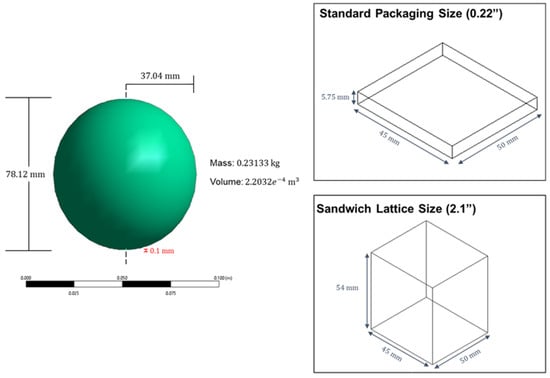
Figure 1.
Modeling Parameters of the Pear Fruit and the Packaging Sizing.

Table 1.
Mechanical Properties of Materials Used in Simulation.
Bio-inspired honeycomb structures are commonly used in the literature due to their good properties in impact-loading without compromising weight []. The corrugated shape is also well documented and generally used in cardboard boxes for transportation purposes []. The dimensions for individual unit cells to be used in the packaging structure are shown in Figure 2.
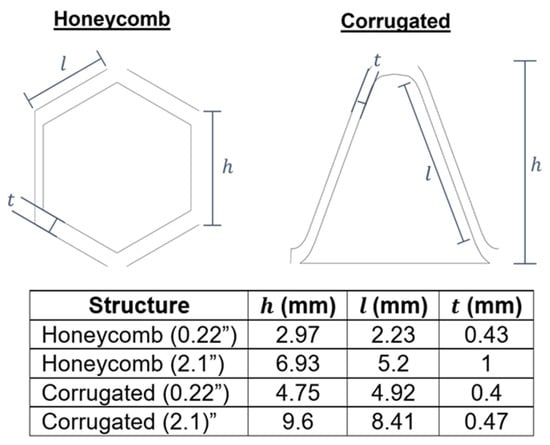
Figure 2.
Unit Cell Dimensions.
The FEA study was performed using Ansys Academic Mechanical, Release 2020R1. A non-linear explicit dynamics solver was used to investigate the drop–impact phenomena of a pear in free fall and to measure the response and bruise susceptibility. Computational analysis has the potential to help improve and optimize the post-harvest handling and transportation process and designs. The analysis was set up with an initial condition of a pre-defined drop height. In this study, three drop heights of 0.25 m, 0.5 m, and 1.0 m were selected, which coincide with drop height ranges also seen in the literature [].
2.2. Mesh Sensitivity and FE Model Validation
The mesh influence on the FEA simulations is minimized through a mesh sensitivity analysis. The choice of parameters, including the mesh generation, is very sensitive to the computational time and accuracy of explicit finite element simulations. Therefore, initial validation through a series of simulations is required to balance computation time and result accuracy. The setup of the mesh sensitivity analysis is shown in Figure 3. A rigid floor was assigned with a fixed body support, and a fruit modeling pear was analyzed for a drop–impact simulation. A standard earth gravity of was defined for all bodies in the negative Y axis. The dimensions and properties of the pear were modeled based on the literature and compared to references of FEA and experimental testing. The pear model was rounded at the contact point to minimize convergence issues due to a perceived initial numerical gap in cases of lower-order elements for mesh bodies []. An initial drop height condition was also defined for the pear to minimize contact instability further, leading to a divergent contact force. A total of 21 simulation scenarios were set up and performed in this study for the pear impact test at different impact platforms, impact heights, and packaging sizes. The pear fruit was modeled with solid elements. Nine different mesh sizes were selected, varying from 10 mm to 1 mm, with a total run time of 0.01 s. Due to the nature of the current rounded simulation, real pears may exhibit different rebound and damage properties as they have more of a ‘teardrop’ than a rounded shape. Nevertheless, the current idealized model was adopted for the initial study as it had good agreement with the literature where spherical representations were found not to have significant differences compared to real shapes in cooling studies [].

Figure 3.
Simulation Setup.
3. Results and Discussion
3.1. Mesh Sensitivity Analysis
The results for the maximum stress convergence are similar to that seen in the literature, with about 5% variation []. This discrepancy could be due to the difference in geometry, as the current work takes an idealized circular shape instead of a scanned pear, and small parameter variances. Figure 4 shows the energy and stress convergence during the drop test simulation study. At lower mesh sizing, there tends to be an underreporting of energy, force, and stress values, also seen in the literature []. The program-controlled mesh degenerates for sizing below 1.5 mm and provides a structured but lower-quality mesh that must be adjusted using a patch-conforming tetrahedral technique. After 2.5 mm mesh sizing, the computation time increases almost exponentially while offering very little in terms of convergence. This computation time trade-off will become more expensive for the lower mesh sizing when also investigating the response and reaction of the elastic behavior of the floors (instead of the rigid support used in the mesh sensitivity analysis). Therefore, a mesh sizing of 1.5 mm will be used in the current simulations to balance the computationally expensive simulations and the accuracy of the results. A total of 139,716 nodes and 602,897 elements were obtained after meshing the pear. The model validation incorporates experimental methods and results from previous work to explore the relationship between drop height, material surface, and bruise severity.
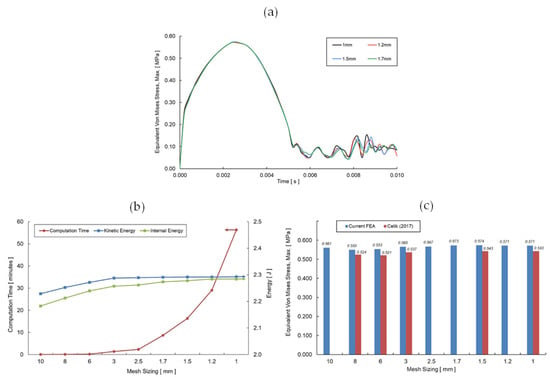
Figure 4.
(a) Maximum Stress Comparison; (b) Pear Impact Energy vs. Computation Time; (c) Current FEA Validation with the Literature.
3.2. Conventional Packaging—Corrugated Cardboard
Cardboard boxes are still the main method by which perishable fruits like apples and pears are transported. A drop test of 1 m was simulated on corrugated cardboard with properties like that found in post-harvest packages for fruits. Conventional packaging used for fruit transportation and handling is usually made using corrugated cardboard []. These cardboards are often only a few millimeters thick, offering very little damping or protection against impacts or vibrations. The results are shown in Figure 5 for a cross-sectional view of a pear that fell onto the cardboard structure from the moment of contact at initial time of 0 ms. The results indicate that a large portion of the structure exceeds the bio-yield point, making bruise susceptibility very high for approximately the lower two-thirds of the pear. The highest stress concentration can be seen near the base, which propagates inside the pear flesh. The last panel shows that there is permanent damage to the cardboard structure due to the impact collision. This shows that thin cardboard packaging is not suitable for post-harvest storage or transportation since further impacts on the already plastically deformed region would reduce any damping properties. Therefore, the search for a more robust packaging material and structure is of great importance for improving the supply of perishable fruits.
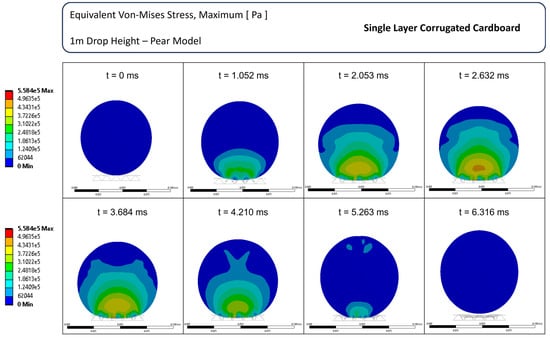
Figure 5.
Maximum Stress Progression for Single Layer Corrugated Cardboard Drop Impact Simulation.
Adding softer layers or damping could improve the susceptibility to bruising for fruits. One of the more economical and practical ways of improving the post-harvest yield could be achieved by layering the packaging material. Stacking layers of cardboard on top of each other provides an additional layer of protection for the fruits without requiring extensive research or capital investment. A comparison between layers of cardboard packaging is shown in Figure 6. What can be seen is that the conventional cardboard packaging used to transport offers little protection when dropped from a height of 1 m, with many regions exceeding the bio-yield criterion for bruising susceptibility. Interestingly, the addition of a double-layer stack dropped the overall stress concentration to almost half that of the single layer and ‘rounded’ the region for the peak stress concentration that was previously seen at 0.002 and 0.004 s for the rigid floor and the single layer. However, adding another layer to the packaging does not seem to have the same measurable improvement in stress reduction going from single to double as it does from double to triple. In the triple-layer packaging simulation, the stress concentration was like that of a double layer until 0.001 s and slightly decreased. This shows that additional layers beyond a double-layer packaging did not show any improvements in the cushioning performance at the point of impact.
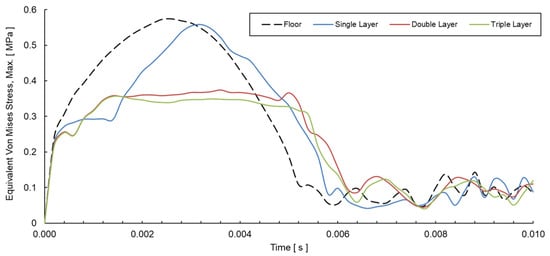
Figure 6.
Maximum Stress Comparison for Cardboard Package Layering at 1 m Drop Height.
A visual stress comparison between the different cardboard packaging layers for a 1 m drop height is shown in Figure 7. A sectioning view plot can be seen to visualize the maximum von Mises stress at the peak stress concentration. Section A-A shows the half-side view of the simulation sectioned from the x-axis, and Section B-B shows the half-front view of the simulation sectioned from the y-axis. What can be seen from the sectional view is that the sizing of the stress propagation decreases across the internal fruit body through the addition of layers, where the maximum pear stress drops by 33% with the addition of a second layer. Alternatively, as shown in Figure 6, the addition of a third layer only reduced the maximum pear stress by 5%. This suggests that the additional layers provide additional cushioning behavior that protects the pears from additional bruising susceptibility. Moreover, the structural damage of the cardboard material, as seen in the last frames of Figure 5, can also be seen for the single and double layering.
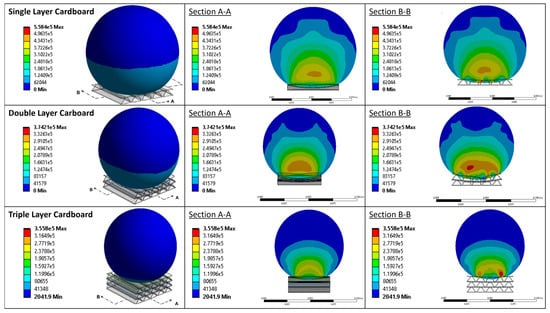
Figure 7.
Stress Comparison of Cardboard Package Layering.
Recently, foam mesh sleeves have been added around fruits in transport as an additional protective layer. These are generally inexpensive to manufacture but still require a person or machinery to apply the sleeve along the supply chain. Additionally, sleeve removal can be labor intensive and risks wounding the soft fruit skin surface []. Moreover, the thin glove does little to support impacts beyond a few centimeters in height as their material and dimensions do not provide adequate damping or energy absorption.
3.3. Rubber
Rubber materials have been well investigated in the literature for offering a good performance-to-weight ratio against low-velocity impacts. The results of the simulated drop tests for the two packaging sizes of rubber at 1 m are shown in Figure 8. Figure 8a,c refer to drop impact simulation on 0.22″ rubber packaging with stress concentrations for the pear and packaging, respectively. Figure 8b,d refer to drop impact simulation on 2.1″ rubber packaging with stress concentrations for the pear and packaging, respectively. For 2.1″ packaging, the drop profile of the rubber at maximum stress appears to have a buckling profile, with the top layer being concaved inwards. As a result, all four sides of the profile experience significant stress and deformation as a result of the 1 m drop height. Alternatively, for the 0.22″ packaging, due to the wall height being significantly smaller, the ‘buckling’ behavior is not as evident, which leads to a higher peak and average pear stress. Investigations in the literature have also shown that rubber has the least impact on fruits and is the most suitable cushioning material for drops [].
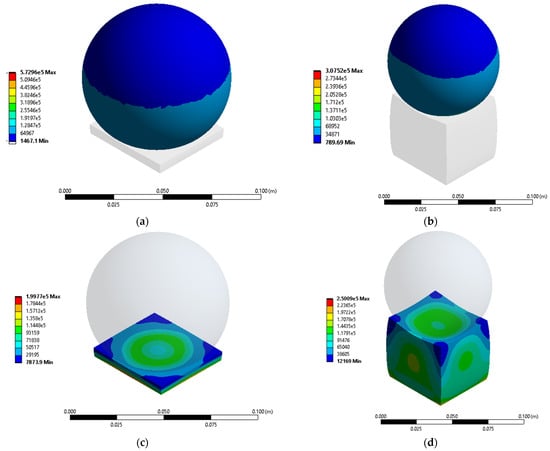
Figure 8.
von Mises Stress Plot for Rubber Simulation at 1 m Drop Height.
3.4. Honeycomb
Recently, 3D-printed honeycomb structures have been investigated in the literature due to the advancement and ease of 3D printing technology. The honeycomb shape offers a good balance of impact resistance performance and strength while having a lower density due to its hollow cells. The results of the simulated drop tests for the two packaging sizes of rubber at 1 m are shown in Figure 9. Figure 9a,c refer to drop impact simulation on 0.22” honeycomb packaging with stress concentrations for the pear and packaging, respectively. Figure 9b,d refer to drop impact simulation on 0.22” rubber packaging with stress concentrations for the pear and packaging, respectively.
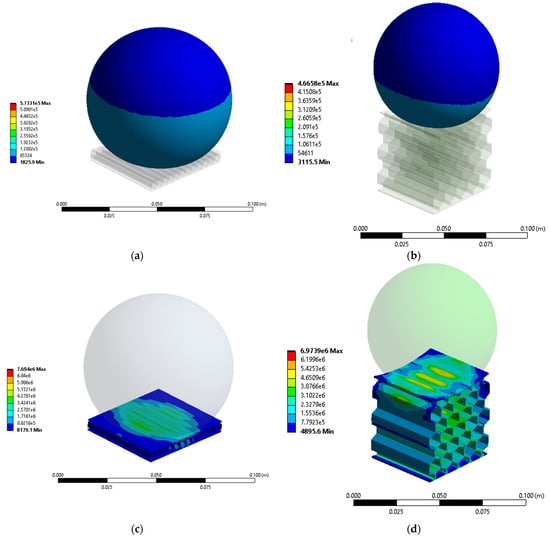
Figure 9.
von Mises Stress Plot for Honeycomb Simulation at 1 m Drop Height.
3.5. Bruising Susceptibility
A summary of the time taken to reach the maximum stress and the rebound time is shown in Table 2. The results show that for the higher drop impacts where the speed is faster, the impact damage increases, and the time taken to reach the maximum stress also decreases. This is evident when the time between the rebound and maximum stress, denoted as t, is lowest for 1 m drop heights, and the time is proportional to the internal energy absorbed by the pear. The instant where the simulation rebound time exceeded the simulation time was only visible in rubber with taller structural height. This suggests that the cushioning and damping properties of this material are dependent on the height due to the buckling shape of the structure.

Table 2.
Drop Impact Simulation Time to Maximum Stress and Rebound.
Figure 10A shows the maximum amount of energy absorbed during the impact; Figure 10B shows the maximum contact force between the pear and the surface; Figure 10C displays the stress plot concentration for the pear; and Figure 10D displays the stress plot concentration for the respective surface. The results showed the expected result that the rigid floor would lead to the highest damage and transfer of energy to the pear because it offered the least amount of protection. The resulting maximum pear stress was 0.572 MPa, which matched the findings in the literature for a wooden floor material []. The rubber material performed the best out of the four surfaces, with a maximum stress of 0.308 MPa. Interestingly, the corrugated cardboard performed similarly, whereby the maximum stress was within 3% of each other when comparing across the different drop heights. Alternatively, the performance of the structure shows that the corrugated cardboard is more susceptible to damage with a higher stress concentration over time when compared to the ABS honeycomb. Damage to the rubber surface was relatively small, and it may have the ability to be reused.
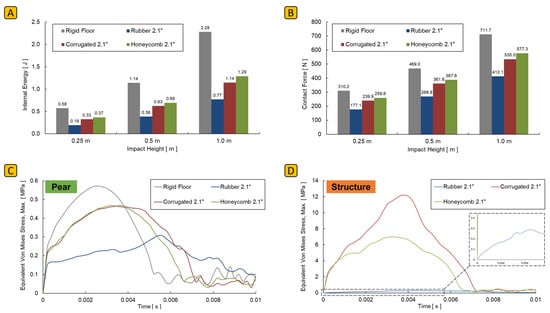
Figure 10.
Drop Impact Simulation for 2.1″ Packaging Material; (A) Internal Energy; (B) Contact Force; (C) Max. von Mises Pear Stress; (D) Max. von Mises Pear Stress.
Figure 11A,B reports the results for the smaller standard packaging material (0.22″). In this set of results, the corrugated shape outperforms the rubber and the honeycomb by minimizing the internal energy absorbed by the pear and the contact force upon impact. There is a very small difference between the rubber and rigid floor results for all three drop heights, suggesting that there is a performance limit to the sizing of the vulcanized rubber. At some heights, such as 0.25 m and 0.5 m, the honeycomb does not perform any better than just dropping the fruit on a wooden floor. This was mainly due to the tip edges of the honeycomb causing sharp points of contact upon which the pear would be more easily damaged; this highlights the fact that the geometrical optimization for lattice structures would be an important consideration for future simulations. Figure 11C shows that the pear experiences almost identical peak stress for all surfaces. However, despite the lower energy transfer to the fruit in the corrugated shape, Figure 11D demonstrates why bruising can still occur for corrugated cardboard packages over long-distance transits. In fact, corrugated cardboard boxes have been shown in the literature to undergo large plastic deformations, which lead to damage []. More study would be required to investigate the effect of impact on damaged corrugated cardboard but would require an exponentially more computationally expensive simulation. The second impact of a fruit during a rebound will lead to subsequent damage and bruising [].
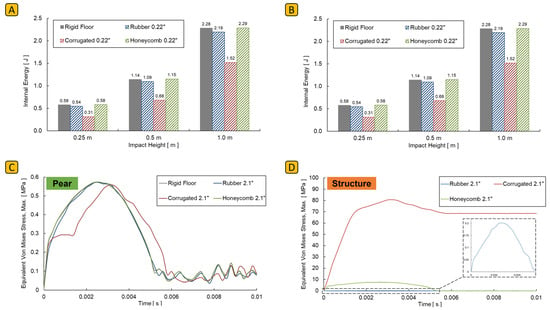
Figure 11.
Drop Impact Simulation for 0.22″ Packaging Material; (A) Internal Energy; (B) Contact Force; (C) Max. von Mises Pear Stress; (D) Max. von Mises Pear Stress.
A comprehensive simulation comparison was carried out using the explicit solver across the different surfaces (rigid floor, rubber, corrugated cardboard, and ABS honeycomb) to model the pear’s fall at three different heights of 0.25 m, 0.5 m, and 1 m, as shown in Table 3. The bruising volume was calculated by extracting the average nodal values over the computational time that exceeded the bio-yield value of 0.3 MPa. This is the maximum stress the pear can sustain before it becomes susceptible to bruising. The maximum and minimum values for the internal energy, contact force, and von Mises stress are summarized for all the drop impact tests with red and green highlighted tables, respectively. The bruising susceptibility was reported by the ratio of bruising volume to the internal energy absorbed by the pear fruit. It can be seen that the 2.1″ vulcanized rubber performed well at 0.25 m and 0.5 m heights, and the 0.22″ corrugated cardboard performed best for the 0.25 m drop height for regions with no bruising susceptibility. Protective padding has been shown to minimize bruising and fresh produce damage []. The bruise susceptibility found in the literature for pears falling at a velocity close to 1.5 m/s (free fall drop height of 0.115 m) was close to 3 × 10−6 /J for a rigid plate at impact, which suggests the current FEA study has good convergence for having a similar order of bruise susceptibility []. The 3D-printed ABS honeycomb would still require further optimization and parameter investigations to improve its performance and protection against bruising. Further improvements should also minimize the contact force, as a relationship between the bruise area and the contact area has been shown in experimental studies []. In the literature, an alternative way to report the bruising property by normalizing the impact of large forces on a small area would be to use a bruise resistance index—this has applications that could be extended to other fruits that have high water contents [].

Table 3.
Bruise Susceptibility of Simulated Drop Impact Tests.
3.6 Response Surface Methodology (RSM)
RSM was utilized to develop predictive empirical models in order to evaluate the bruise susceptibility for a wide range of impact cases [,].
In this study, prediction models were developed utilizing the RSM approach to predict bruise susceptibility for each impact material, where bruise susceptibility () is a function of drop height (, and of packaging size ( as follows.
Results are illustrated in 3D surface plots as shown in Figure 12a,b for 0.22″ and 2.1″ packaging sizes, respectively. According to surface plots, predicted bruise susceptibility values match the simulated values. For packaging size of 0.22″ (Figure 12a), low bruises are reported for corrugated cardboard at low drop heights. Similarly, for 2.1″ packaging, rubber material outperformed at different impact height ranges.
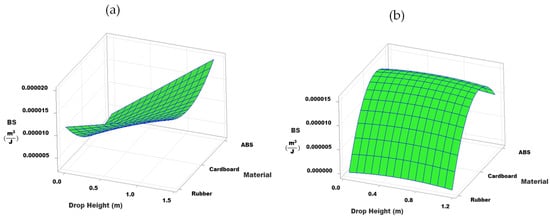
Figure 12.
Response surface diagram for packaging size (a) 0.22″ and (b) 2.1″.
Coefficient of determination values () were obtained from response surfaces as follows: 0.93 for rigid, 0.99 for rubber, 0.87 for cardboard, and 0.84 for ABS. Although the coefficient of determination values indicates that the predicted empirical model is reasonable, further evaluation is needed. Therefore, simulated bruise susceptibility (BS) values of the FEA model were compared with predicted BS values of RSM. Relative error (%) between simulated and predicted BS values are shown in Table 4 and Table 5. It is worth noting that absolute error was calculated instead of relative error in instances where simulated bruise susceptibility equals zero due to the inability to divide by zero. Relative error values ranged from 1% to 24%, which is considered acceptable given the current complexity of bruise volume measurement for fresh produce []. Similar error ranges have been reported in the literature, where error values ranged from 7% to 26% for a prediction model for apple damage [].

Table 4.
Relative error between simulated and predicted BS values for rigid impact platform.

Table 5.
Relative error between simulated and predicted BS values for rubber, cardboard, and ABS impact platforms.
Therefore, the developed response surface method and prediction models can be regarded as reasonable and satisfactory.
4. Conclusions
This paper investigates four different packaging materials and structures that could be used to improve the handling and transportation of pear fruits in post-harvest transportation using FEA methods. A computational explicit dynamics software using Ansys Academic Mechanical, Release 2020R1 was used to perform drop height simulations at 0.25 m, 0.5 m, and 1.0 m on two packaging sizes (0.22″ and 2.1″) for vulcanized rubber, corrugated cardboard, and 3D-printed ABS. The key findings from the study revealed that:
- Conventional corrugated cardboard packaging is very prone to plastic and permanent structural for any fruit drop height;
- A double-layer corrugated structure can reduce the maximum pear stress by about 33%, but subsequent layers do not greatly improve the protection against fall damage;
- Vulcanized rubber has a critical height performance limit for cushioning protection; there does not seem to be any benefit of using 0.22″ thickness rubber packaging;
- For 2.1″ packaging size, vulcanized rubber performed the best at all heights with minimal bruising susceptibility, while 0.22″ size corrugated cardboard performed the best at 0.25 m;
- 3D-printed material could potentially lead to multi-use protective packaging that does not get damaged, but the rigidity of ABS materials is currently not suitable for fruit drop protection;
- FEA-simulated bruise susceptibility values were compared with RSM-predicted values where relative error did not exceed 24%, which supports the adoption of the theoretical model as an effective tool for decision-making in agriculture and the post-harvest sector.
Overall, the reported findings suggest that packaging performance that falls between rubber and corrugated at 0.22″ packaging size is most effective for current post-harvest transport technology. Future work on minimizing bruising susceptibility should focus on a mixture of design and material technology. Investigation of reusable or recycled plastic-based packaging and cushioning designs would enhance and boost post-harvest logistics. Overall better protection for the fruits can help improve the sustainability of post-harvest technologies and improve food security.
Author Contributions
Conceptualization, F.T. and P.B.P.; Data curation, M.H. and A.M.; Formal analysis, M.H. and A.M.; Funding acquisition, F.T. and P.B.P.; Methodology, all authors; Project administration, F.T. and P.B.P.; Software, M.H. and A.M.; Supervision, F.T. and P.B.P.; Writing—original draft, M.H. and A.M.; Writing—review and editing, all authors. All authors have read and agreed to the published version of the manuscript.
Funding
This research was funded by Qatar University—International Research Collaboration Grant no. IRCC-2023-001 and Sultan Qaboos University CL\SQU\QU\AGR\23\02.
Institutional Review Board Statement
Not applicable.
Informed Consent Statement
Not applicable.
Data Availability Statement
The original contributions presented in the study are included in the article, further inquiries can be directed to the corresponding author/s
Acknowledgments
We would like to thank Qatar University and Sultan Qaboos University for their support to the this work. Open Access funding was provided by the Qatar National Library. The findings of this study are solely the responsibility of the authors.
Conflicts of Interest
The authors declare no conflicts of interest.
References
- Al-Dairi, M.; Pathare, P.B.; Al-Yahyai, R.; Opara, U.L. Mechanical Damage of Fresh Produce in Postharvest Transportation: Current Status and Future Prospects. Trends Food Sci. Technol. 2022, 124, 195–207. [Google Scholar] [CrossRef]
- Expert Group. A Study of Waste in the Cold Food Chain and Opportunities for Improvement; Expert Group: Brighton, VA, Australia, 2020. [Google Scholar]
- Ma, L.; Zheng, Y.; Sang, Z.; Ge, Y.; Bai, C.; Fu, A.; Wang, Q.; Watkins, C.B.; Zuo, J. Multi-Omics Analysis Reveals the Mechanism of Calcium-Reduced Quality Deterioration in Mechanically Injured Green Pepper Fruit. Postharvest Biol. Technol. 2023, 204, 112437. [Google Scholar] [CrossRef]
- Satitmunnaithum, J.; Kitazawa, H.; Arofatullah, N.A.; Widiastuti, A.; Kharisma, A.D.; Yamane, K.; Tanabata, S.; Sato, T. Microbial Population Size and Strawberry Fruit Firmness after Drop Shock-Induced Mechanical Damage. Postharvest Biol. Technol. 2022, 192, 112008. [Google Scholar] [CrossRef]
- Pathare, P.B.; Al-Dairi, M. Bruise Susceptibility and Impact on Quality Parameters of Pears During Storage. Front. Sustain. Food Syst. 2021, 5, 658132. [Google Scholar] [CrossRef]
- Hussein, Z.; Fawole, O.A.; Opara, U.O. Effects of Bruising and Storage Duration on Physiological Response and Quality Attributes of Pomegranate Fruit. Sci. Hortic. 2020, 267, 109306. [Google Scholar] [CrossRef]
- Hussein, Z.; Fawole, O.A.; Opara, U.L. Investigating Bruise Susceptibility of Pomegranate Cultivars during Postharvest Handling. Afr. J. Rural Dev. 2017, 2, 33–39. [Google Scholar]
- Opara, U.L.; Pathare, P.B. Bruise Damage Measurement and Analysis of Fresh Horticultural Produce—A Review. Postharvest Biol. Technol. 2014, 91, 9–24. [Google Scholar] [CrossRef]
- Körzendörfer, A. Vibrations and Ultrasound in Food Processing–Sources of Vibrations, Adverse Effects, and Beneficial Applications–An Overview. J. Food Eng. 2022, 324, 110875. [Google Scholar] [CrossRef]
- Ngo, T.D.; Kashani, A.; Imbalzano, G.; Nguyen, K.T.Q.; Hui, D. Additive Manufacturing (3D Printing): A Review of Materials, Methods, Applications and Challenges. Compos. B Eng. 2018, 143, 172–196. [Google Scholar] [CrossRef]
- Cornaggia, A.; Gajewski, T.; Knitter-Piątkowska, A.; Garbowski, T. Influence of Humidity and Temperature on Mechanical Properties of Corrugated Board—Numerical Investigation. Bioresources 2023, 18, 7490–7509. [Google Scholar] [CrossRef]
- Najafi, M.; Ahmadi, H.; Liaghat, G.H. Evaluation of the Mechanical Properties of Fully Integrated 3D Printed Polymeric Sandwich Structures with Auxetic Cores: Experimental and Numerical Assessment. Int. J. Adv. Manuf. Technol. 2022, 122, 4079–4098. [Google Scholar] [CrossRef]
- Zulkifli, N.; Hashim, N.; Harith, H.H.; Shukery, M.F.M. Finite Element Modelling for Fruit Stress Analysis—A Review. Trends Food Sci. Technol. 2020, 97, 29–37. [Google Scholar] [CrossRef]
- Fadiji, T.; Coetzee, J.; Berry, T.M.; Ambaw, A.; Opara, U.L. The Efficacy of Finite Element Analysis (FEA) as a Design Tool for Food Packaging: A Review. J. Food Eng. 2018, 4, 20–40. [Google Scholar] [CrossRef]
- Celik, H.K. Determination of Bruise Susceptibility of Pears (Ankara Variety) to Impact Load by Means of FEM-Based Explicit Dynamics Simulation. Postharvest Biol. Technol. 2017, 128, 83–97. [Google Scholar] [CrossRef]
- Hussein, Z.; Fawole, O.A.; Opara, U.L. Bruise Damage Susceptibility of Pomegranates (Punica Granatum, L.) and Impact on Fruit Physiological Response during Short Term Storage. Sci. Hortic. 2019, 246, 664–674. [Google Scholar] [CrossRef]
- Van Zeebroeck, M.; Darius, P.; De Ketelaere, B.; Ramon, H.; Tijskens, E. The Effect of Fruit Properties on the Bruise Susceptibility of Tomatoes. Postharvest Biol. Technol. 2007, 45, 168–175. [Google Scholar] [CrossRef]
- Yousefi, S.; Farsi, H.; Kheiralipour, K. Drop Test of Pear Fruit: Experimental Measurement and Finite Element Modelling. Biosyst. Eng. 2016, 147, 17–25. [Google Scholar] [CrossRef]
- Du, D.; Wang, B.; Wang, J.; Yao, F.; Hong, X. Prediction of Bruise Susceptibility of Harvested Kiwifruit (Actinidia Chinensis) Using Finite Element Method. Postharvest Biol. Technol. 2019, 152, 36–44. [Google Scholar] [CrossRef]
- Nikara, S.; Ahmadi, E.; Nia, A.A. Finite Element Simulation of the Micromechanical Changes of the Tissue and Cells of Potato Response to Impact Test during Storage by Scanning Electron Microscopy. Postharvest Biol. Technol. 2020, 164, 111153. [Google Scholar] [CrossRef]
- Zhao, J.; Sugirbay, A.; Chen, Y.; Zhang, S.; Liu, F.; Bu, L.; Chen, Y.; Wang, Z.; Chen, J. FEM Explicit Dynamics Simulation and NIR Hyperspectral Reflectance Imaging for Determination of Impact Bruises of Lycium Barbarum L. Postharvest Biol. Technol. 2019, 155, 102–110. [Google Scholar] [CrossRef]
- Guan, X.; Li, T.; Zhou, F. Determination of Bruise Susceptibility of Fresh Corn to Impact Load by Means of Finite Element Method Simulation. Postharvest Biol. Technol. 2023, 198, 112227. [Google Scholar] [CrossRef]
- Lin, M.; Fawole, O.A.; Saeys, W.; Wu, D.; Wang, J.; Opara, U.L.; Nicolai, B.; Chen, K. Mechanical Damages and Packaging Methods along the Fresh Fruit Supply Chain: A Review. Crit. Rev. Food Sci. Nutr. 2022, 63, 10283–10302. [Google Scholar] [CrossRef] [PubMed]
- Celik, H.K.; Ustun, H.; Erkan, M.; Rennie, A.E.W.; Akinci, I. Effects of Bruising of ‘Pink Lady’Apple under Impact Loading in Drop Test on Firmness, Colour and Gas Exchange of Fruit during Long Term Storage. Postharvest Biol. Technol. 2021, 179, 111561. [Google Scholar] [CrossRef]
- Lewis, R.; Yoxall, A.; Canty, L.A.; Romo, E.R. Development of Engineering Design Tools to Help Reduce Apple Bruising. J. Food Eng. 2007, 83, 356–365. [Google Scholar] [CrossRef]
- Ashby, M. Material Property Data for Engineering Materials—ANSYS Granta Edupack 2021; ANSYS: Canonsburg, CA, USA, 2021. [Google Scholar]
- Lee, I.T.; Shi, Y.; Afsar, A.M.; Ochi, Y.; Bae, S.I.; Song, J.I. Low Velocity Impact Behavior of Aluminum Honeycomb Structures. Adv. Compos. Mater. 2010, 19, 19–39. [Google Scholar] [CrossRef]
- Silva, N.; Molina-Besch, K. Replacing Plastic with Corrugated Cardboard: A Carbon Footprint Analysis of Disposable Packaging in a B2B Global Supply Chain—A Case Study. Resour. Conserv. Recycl. 2023, 191, 106871. [Google Scholar] [CrossRef]
- Hou, J.; Zhu, Z.; Hu, W.; He, Z.; Sun, Q.; Yue, X. Analysis of Damage Caused by Drop Impacts for Mulberry Fruits: An Dropping Experiment and Numerical Simulation. J. Food Process Eng. 2023, 46, e14316. [Google Scholar] [CrossRef]
- Ma, Y.; Markine, V.L.; Mashal, A.A.; Ren, M. Effect of Wheel-Rail Interface Parameters on Contact Stability in Explicit Finite Element Analysis. Proc. Inst. Mech. Eng. F J. Rail Rapid Transit. 2018, 232, 1879–1894. [Google Scholar] [CrossRef]
- Gruyters, W.; Verboven, P.; Diels, E.; Rogge, S.; Smeets, B.; Ramon, H.; Defraeye, T.; Nicolaï, B.M. Modelling Cooling of Packaged Fruit Using 3D Shape Models. Food Bioprocess Technol. 2018, 11, 2008–2020. [Google Scholar] [CrossRef]
- Pathare, P.B.; Opara, U.L.; Vigneault, C.; Delele, M.A.; Al-Said, F.A.-J. Design of Packaging Vents for Cooling Fresh Horticultural Produce. Food Bioprocess Technol. 2012, 5, 2031–2045. [Google Scholar] [CrossRef]
- Xin, D.; Ning, D.; Wang, K.; Han, Y. Development of on Line Automatic Separation Device for Apple and Sleeve. AIP Conf. Proc. 2018, 1955, 40081. [Google Scholar] [CrossRef]
- Ni, X.; Jiang, H.; Wang, L.; Shi, W. Kinetics Simulation of the Crucial Points on a Fruit Grading and Packing Line. In Proceedings of the 2018 ASABE Annual International Meeting, Dearborn, MI, USA, 31 July 2018; p. 1. [Google Scholar]
- Djilali Hammou, A.; Minh Duong, P.T.; Abbès, B.; Makhlouf, M.; Guo, Y.-Q. Finite-Element Simulation with a Homogenization Model and Experimental Study of Free Drop Tests of Corrugated Cardboard Packaging. Mech. Ind. 2012, 13, 175–184. [Google Scholar] [CrossRef]
- Lien, C.C.; Ting, C.H. Assessing Guava Maturity by Statistical Analyses of Dropped Fruit Impact Responses. Postharvest Biol. Technol. 2014, 95, 20–27. [Google Scholar] [CrossRef]
- Xu, R.; Takeda, F.; Krewer, G.; Li, C. Measure of Mechanical Impacts in Commercial Blueberry Packing Lines and Potential Damage to Blueberry Fruit. Postharvest Biol. Technol. 2015, 110, 103–113. [Google Scholar] [CrossRef]
- Stropek, Z.; Gołacki, K. Bruise Susceptibility and Energy Dissipation Analysis in Pears under Impact Loading Conditions. Postharvest Biol. Technol. 2020, 163, 111120. [Google Scholar] [CrossRef]
- Komarnicki, P.; Stopa, R.; Szyjewicz, D.; Młotek, M. Evaluation of Bruise Resistance of Pears to Impact Load. Postharvest Biol. Technol. 2016, 114, 36–44. [Google Scholar] [CrossRef]
Disclaimer/Publisher’s Note: The statements, opinions and data contained in all publications are solely those of the individual author(s) and contributor(s) and not of MDPI and/or the editor(s). MDPI and/or the editor(s) disclaim responsibility for any injury to people or property resulting from any ideas, methods, instructions or products referred to in the content. |
© 2024 by the authors. Licensee MDPI, Basel, Switzerland. This article is an open access article distributed under the terms and conditions of the Creative Commons Attribution (CC BY) license (https://creativecommons.org/licenses/by/4.0/).